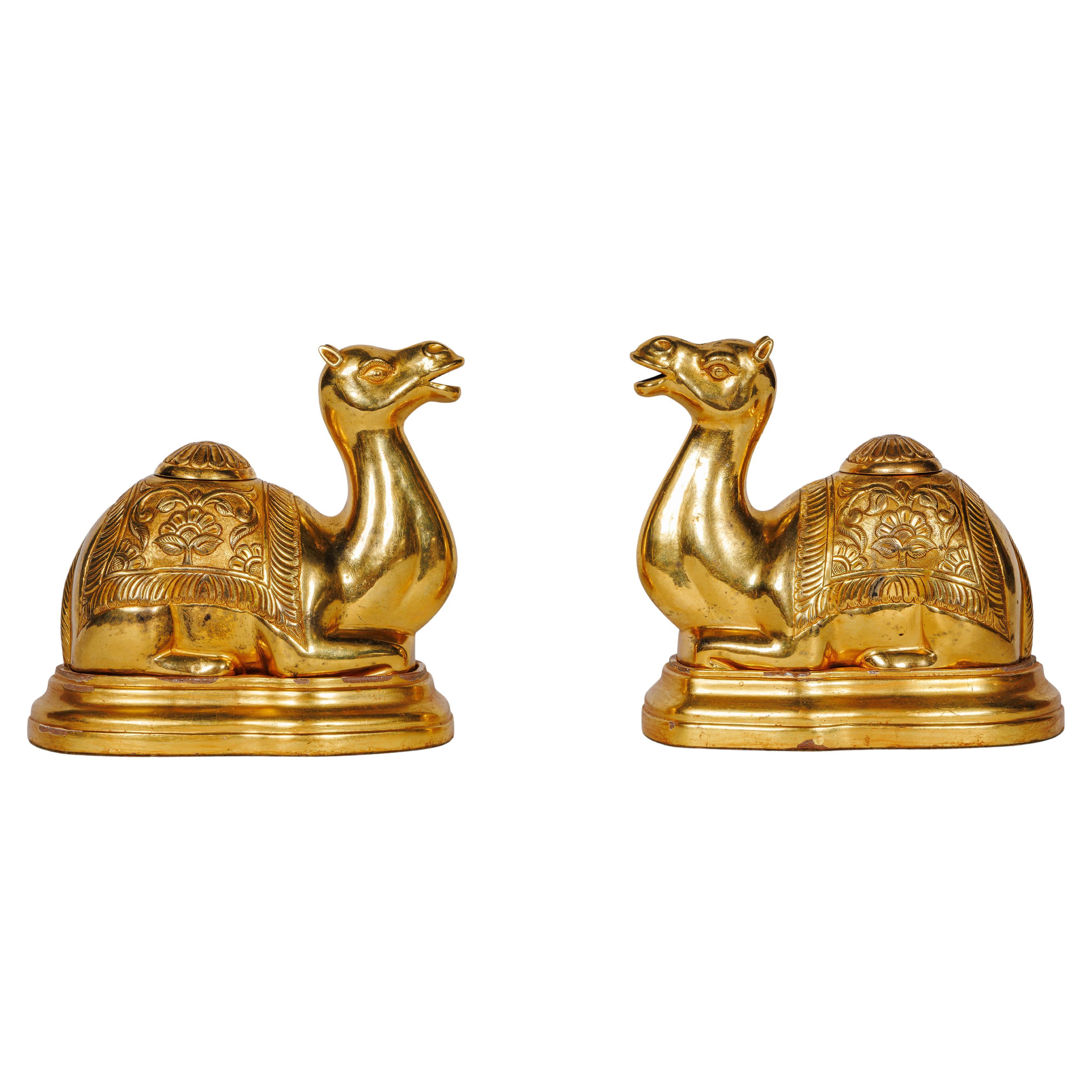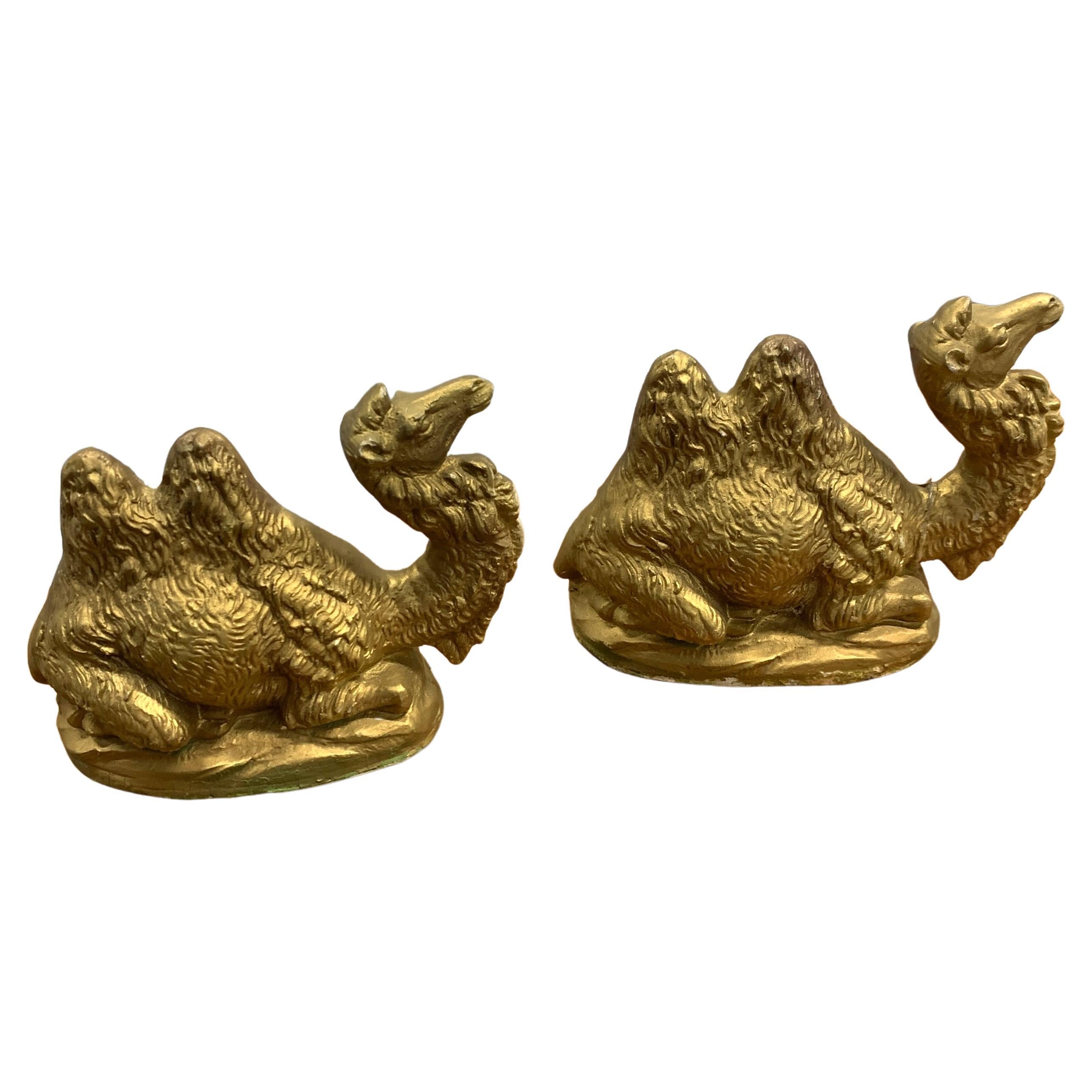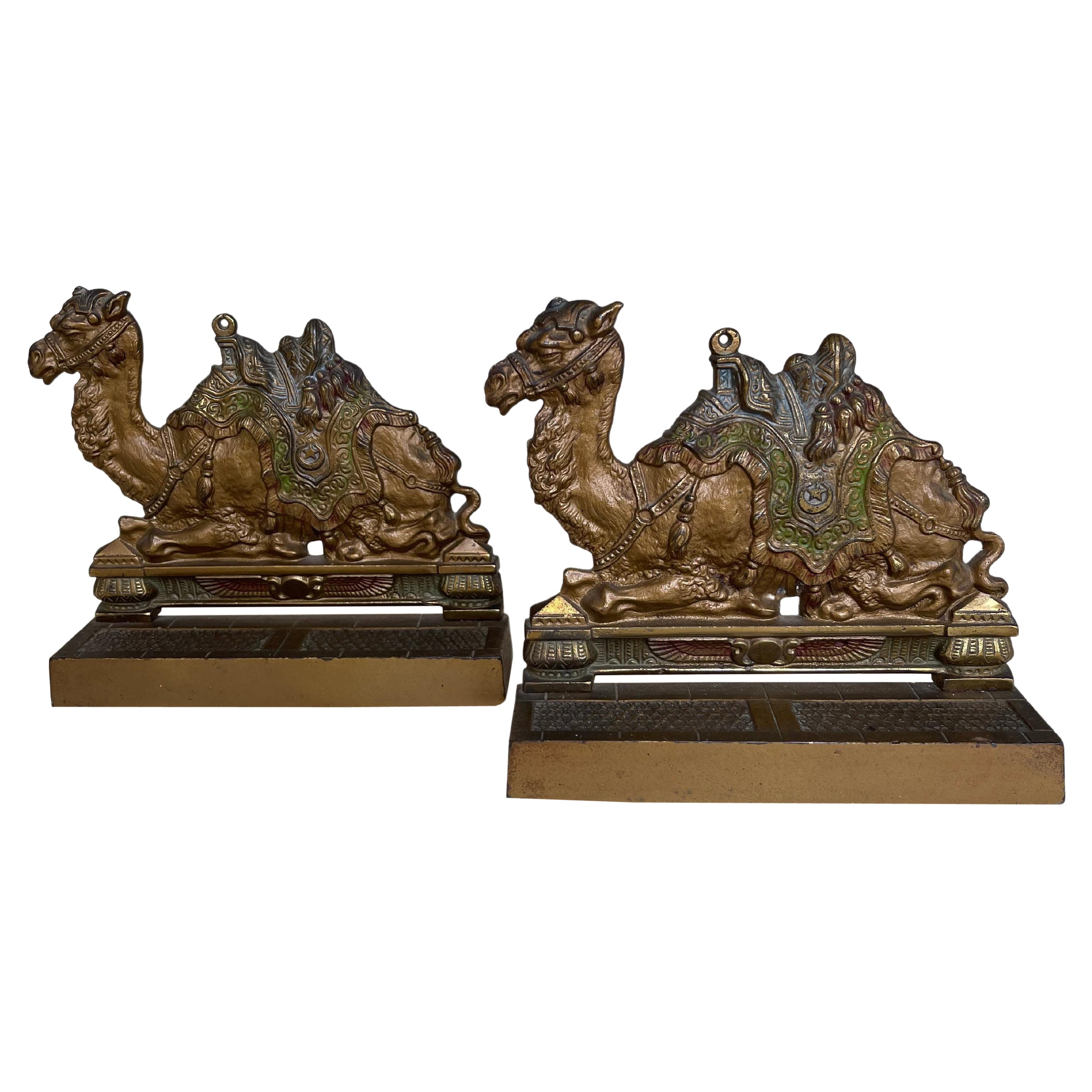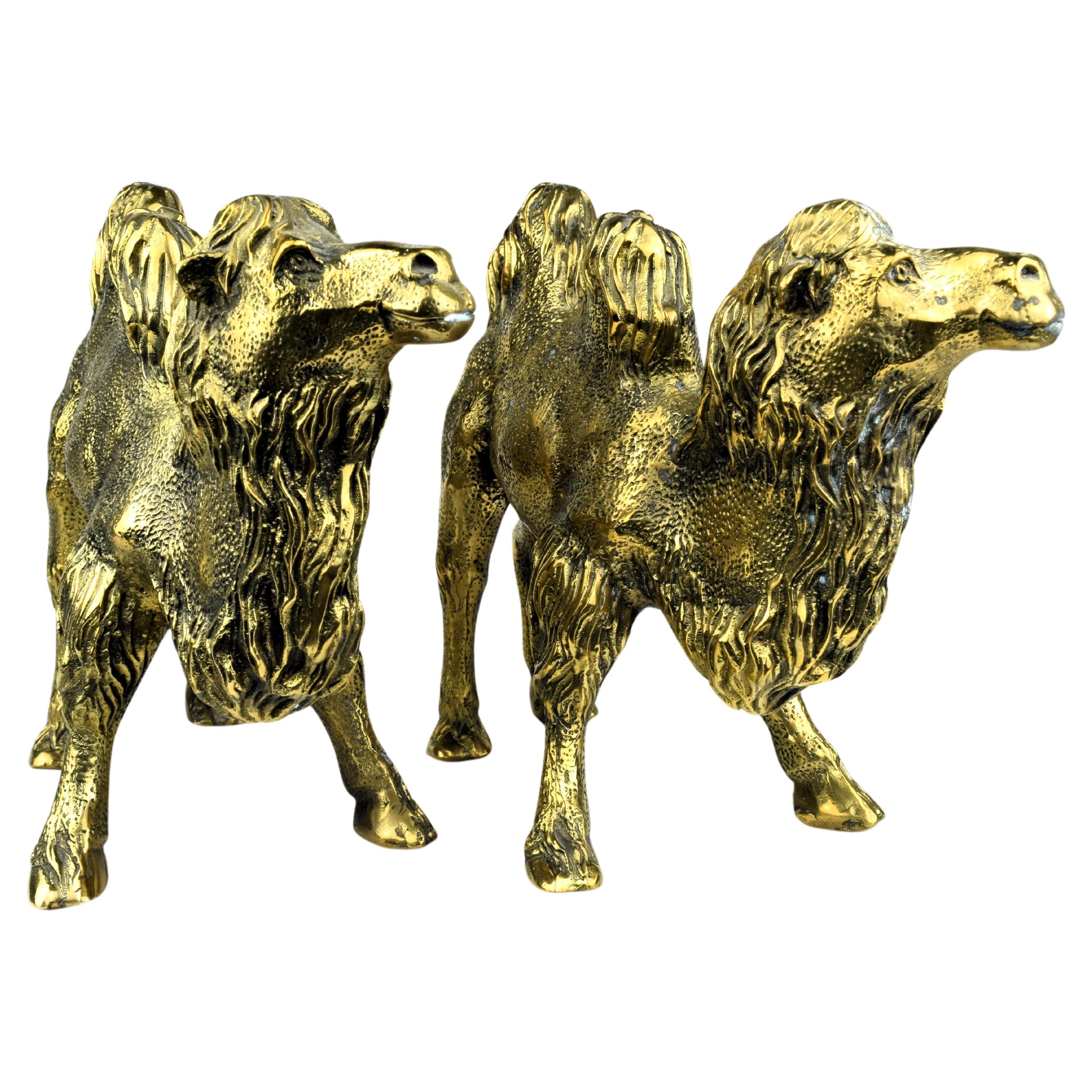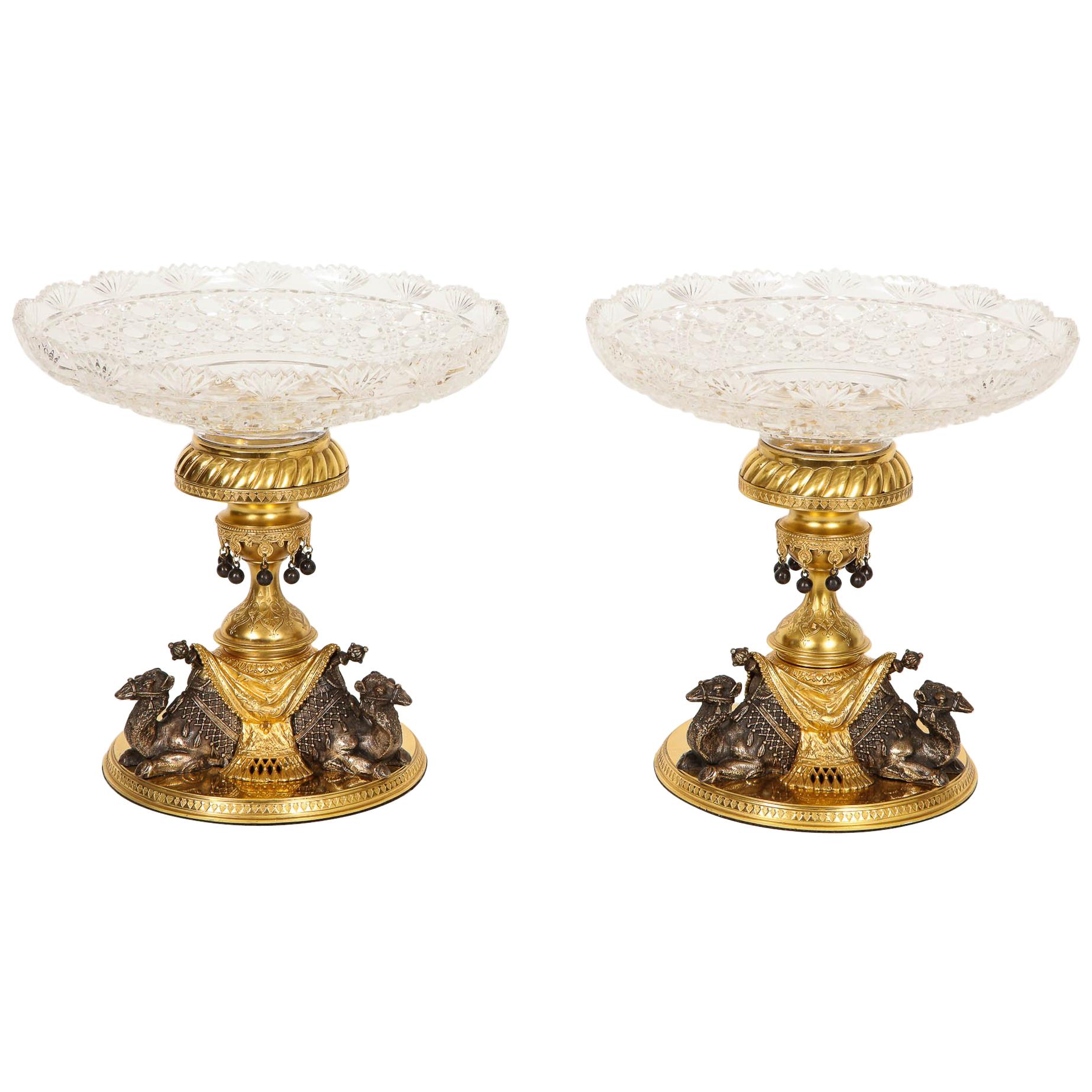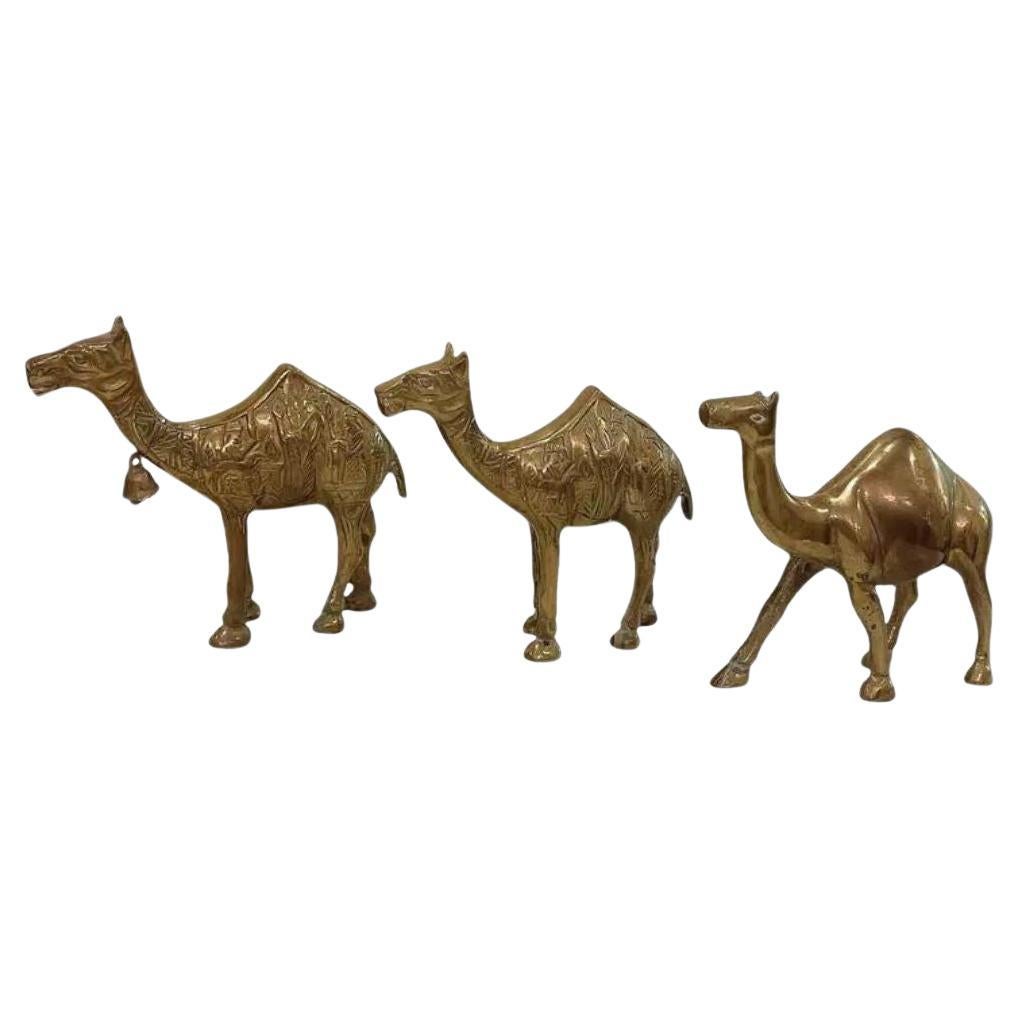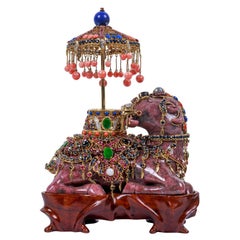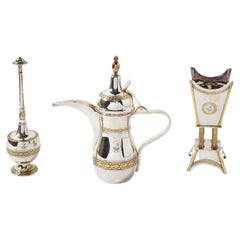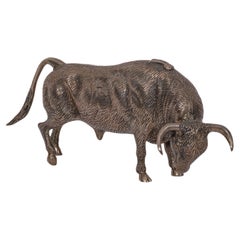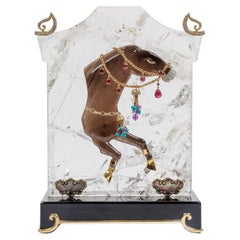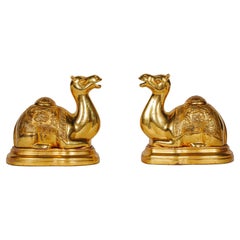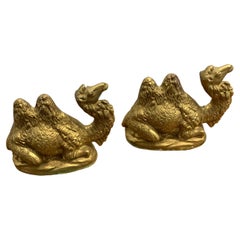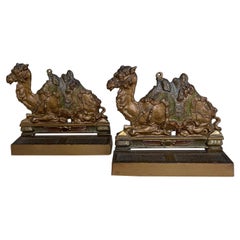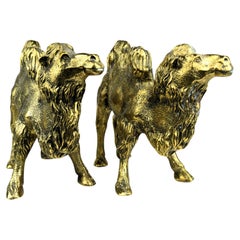Items Similar to A Pair of Opulent Sterling Silver-Gilt Camel Incense Burners, circa 1900
Video Loading
Want more images or videos?
Request additional images or videos from the seller
1 of 8
A Pair of Opulent Sterling Silver-Gilt Camel Incense Burners, circa 1900
$12,000
£9,187.89
€10,526.44
CA$17,123.53
A$18,741.41
CHF 9,741.88
MX$225,559.33
NOK 122,470.78
SEK 114,881.41
DKK 78,625.67
About the Item
A Pair of Opulent Sterling Silver-Gilt 925 Camel Incense Burners on Giltwood Stands, Circa 1900
Masterfully crafted, these pieces epitomize the grandeur and sophistication of the period, adorned with sumptuous silver-gilt that captures the majestic essence of the camels.
In Middle Eastern culture, camels hold profound significance as symbols of endurance, grace, and nobility. Revered for their role in traversing vast deserts, camels are often associated with prosperity and travel. The artistry of these burners pays homage to their esteemed place in tradition, rendering them with intricate detailing and an air of regal elegance.
Each camel is elegantly mounted on its original giltwood stand that enhance the opulence of the piece. The burners are designed not just as functional objects but as exquisite works of art, reflecting the cultural practice of incense burning—a ritual deeply ingrained in many cultures for its spiritual and purifying qualities. The act of burning incense symbolizes the elevation of the soul and the sanctification of space, resonating with a sense of tranquility and refinement.
The incense is cleverly placed inside the camels, allowing fragrant aromas to emerge gracefully through their mouths.
This pair of silver-gilt camel incense burners stands as a testament to both artistic excellence and cultural heritage. Their combination of lavish craftsmanship and symbolic significance makes them a remarkable addition to any distinguished collection, offering a touch of timeless elegance and historical depth.
Marked 925 on the bottom of the camel.
Camels: 5.5” high x 7” wide
Stands: 1.5” high
Weighs approximately 32 ounces
Very good condition. Normal wear consistent with age and use.
- Metal:
- Dimensions:Height: 5.5 in (139.7 mm)Width: 7 in (177.8 mm)Depth: 2 in (50.8 mm)
- Period:
- Date of Manufacture:C. 1900
- Condition:Wear consistent with age and use.
- Seller Location:Long Island City, NY
- Reference Number:1stDibs: LU1494224012862
About the Seller
No Reviews Yet
Vetted Professional Seller
Every seller passes strict standards for authenticity and reliability
Established in 1980
1stDibs seller since 2019
7 sales on 1stDibs
- ShippingRetrieving quote...Shipping from: Long Island City, NY
- Return Policy
Authenticity Guarantee
In the unlikely event there’s an issue with an item’s authenticity, contact us within 1 year for a full refund. DetailsMoney-Back Guarantee
If your item is not as described, is damaged in transit, or does not arrive, contact us within 7 days for a full refund. Details24-Hour Cancellation
You have a 24-hour grace period in which to reconsider your purchase, with no questions asked.Vetted Professional Sellers
Our world-class sellers must adhere to strict standards for service and quality, maintaining the integrity of our listings.Price-Match Guarantee
If you find that a seller listed the same item for a lower price elsewhere, we’ll match it.Trusted Global Delivery
Our best-in-class carrier network provides specialized shipping options worldwide, including custom delivery.More From This Seller
View AllExquisite 14K Gold, Diamonds, Emeralds, Rubies, Semi Precious Stone Camel
Located in Long Island City, NY
An Exquisite 14K Gold, Diamonds, Emeralds, Rubies, Sapphires, and Semi Precious Stone Mounted Rhodonite Camel.
Circa 1970, Italy
A very good quality and unusual gold mounted jeweled object...
Category
20th Century Italian Figurines and Sculptures
Materials
Coral, Diamond, Emerald, Moonstone, Pearl, Ruby, Blue Sapphire, 14k Gold
Margaret Thatcher and State of Qatar, Garrard & Co. Silver Gilt Presentation Set
By Garrard & Co. Ltd.
Located in Long Island City, NY
Margaret Thatcher and State of Qatar, Garrard & Co. Silver Gilt Presentation Set, London, 1983.
MARK OF GARRARD LTD, LONDON, 1983
A Three piece Elizabeth II, silver and silver ...
Category
20th Century British Enamel Frames and Objects
Materials
Silver
$45,000 / set
Free Shipping
A Rare Buccellati Italy Sterling Silver Model of a Bull
By Buccellati
Located in Long Island City, NY
A Rare Buccellati Italy Sterling Silver Model of a Bull, Numbered 7
An impressive and finely detailed sterling silver model of a bull by Buccellati, Italy, numbered 7. Exquisitely h...
Category
20th Century Italian Figurines and Sculptures
Materials
Sterling Silver
Mellerio Paris, a French Gold, Diamonds, Silver, and Smoky Quartz Carved Horse
By Mellerio dits Meller
Located in Long Island City, NY
Mellerio Paris, A French Gold, Diamonds, Silver-Gilt, Rock-Crystal, Jade, Mother-Of-Pearl and Smoky Quartz, Carved Horse Sculpture, Jeweled Mounted Object.
An extremely rare and unique, one of a kind French gold, diamonds, Silver-gilt, rock-crystal, jade, obsidian, mother-of-pearl, and smoky quartz carved jeweled sculpture "CHEVAUX DE LEGENDE", "A Legendary Horse" by Mellerio, Paris, circa 1991.
Sitting on black obsidian base, the solid rock-crystal slab is finely applied with a carved smoky -quartz and jade horse with a harness mounted in 18k gold, brilliant -cut diamonds, rubies, turquoise, and amethyst chains and pendants. The top columns adorned with 18k gold and brilliant cut diamond pendants, the bottom with gold and mother of pearl plaques. The obsidian base with a plaque engraved: CHEVAUX DE LEGENDE" / N° 05 / MELLERIO DITS MELLER / PARIS / 5003 D
The piece is in excellent condition and comes with a custom made wood case made for transport. It's very elegant and has French hallmarks throughout. A truly magnificent piece.
Measures 10.5" high x 8.5" wide x 4" deep
Founded in France in 1613 by the descendants of Italian immigrants from the Vigezzo Valley in the north of Italy, Mellerio is one of the oldest jewellery houses in Europe. The family business soon attracted the attention of the Royal Court and Marie Antoinette herself reportedly purchased a precious bracelet featuring 7 cameos surrounded by rubies in 1780. Later on, in the 19th century, Mellerio became the official supplier of the French Royal family and the Court of Netherland.
Mellerio creates many jewellery items, all set with rare gems such as peridots, amethysts, aquamarines, citrines and topaz, applying for a patent, the flexible stem, a very supple and light jewellery mechanism. Mellerio remains also well known for their spectacular series of Art Nouveau jewels, created at the beginning of the 20th century, as well as for the creation of trophies rewarding some of the greatest footfall and tennis players of history. In 1993, the jewellery house launched their first watch collection.
Today, Mellerio has stores in Paris, Japan and Hong Kong.
July 14, 1789: this date is known throughout the world as the beginning of the French Revolution. According to a ledger belonging to House of Mellerio, this was also the day that the jeweler sold a golden key to the Comte de Coutance for 10 livres. This ledger, as well as inventories dating as far back as 1768, are the jeweler’s oldest archives. These archives have continued to grow over the years, as the House, established on rue de la Paix in Paris, still lives on today, still in the hands of the same family from Craveggia, in the North of Italy.
The tumultuous history of the Mellerio family in France probably goes as far back as the Italian wars of the Renaissance, but the first official document proving their commercial activity in Paris dates back to 1613. This document is the famous royal warrant awarded by Marie de Medici to a number of Italian families established along the rue des Lombards, including the Mellerios, allowing them to sell “small jewelery items”, therefore granting them a small exception to the traditional monopoly enjoyed by Parisian jewelers. At that time, powerful corporations regulated the operations and customs of Parisian business, but thanks to this exceptional warrant, the Mellerios managed to escape the confines of this framework. Today, this wax-sealed document is kept at the city hall of Craveggia.
From 1613 to the Revolution, the Mellerios lived between France and Italy. The corporations tried many times to put an end to their trade privileges, but all in vain, as a dynasty of sovereigns renewed the warrant. Always marrying and often retiring in Craveggia, the Mellerios continued to maintain their jewelry business in Paris. At first, they did this without a shop. Wearing backpacks (wooden boxes divided into small compartments where jewels were kept), they would tour town fairs around Paris and royal castles.
This is how Jean-Baptiste Mellerio (1765-1850) is said to have sold a bracelet set with rubies and Antique cameos to Marie-Antoinette, which still exists today. Many elements seem to prove the veracity of this anecdote. The queen was particularly fond of cameos, which cover the entire background of her famous jewelry cabinet, and ruby was her favorite stone after diamond. The famous bracelet, reacquired a few years ago by the House of Mellerio, is indeed an 18th century jewel, set with antique cameos representing the profiles of Roman emperors. Two branches of the family were operating in Paris during this time, under the reign of Louis XVI: that of Jean-François (1746-1828), the paternal ancestor of the current Mellerios, and that of Jean-Baptiste (1765-1850).
The French Revolution forced them to return to Italy. However, both Jean-Baptiste and François Mellerio (1772-1843), who was the son of Jean-François, were eventually able to return to Paris after the founding of the Consulate. Jean-Baptiste opened a shop at the Iron Crown of rue Vivienne, and François opened his at the Palais des Tuileries, rue du Coq Saint-Honoré. His well-organized order books give an idea of his high-ranking clientele during the “Old Regime”, among which were the Comte and Comtesse Octave de Segur, the Marquise (later Duchess) de Tourzel, former governess of the royal children, and her daughter, the Comtesse de Bearn, the Craufurds -who organized the flight to Varennes, the Duc and Duchess de Gramont, the Comtesse de Boigne, and Madame de Souza, Talleyrand’s mistress.
We also see the names of the imperial family: Empress Josephine, the Queen of Holland, Princess Elisa, Caroline and Pauline. At that time, the House of Mellerio specialized, among other things, in the trade of antique cameos, a newly fashionable genre of jewel that captured the imagination of all the princesses and noble women of the time.
The years of the Restauration and July Monarchy were among the most glorious. The Bourbons were back on the throne, and the clientele of the House of Mellerio had regained its former wealth. Mellerio supplied Louis-Philippe, Duke of Orléans, as well as his mother, wife and sister, with sumptuous jewels, including a set of emeralds made piece by piece, while the Duke of Bourbon, last prince of the House of Condé, offered diamonds to his mistress, the scheming Baronne de Feucheres, and Monsieur de LaFayette also bought cameos for one of his granddaughters. For the first time, Mellerio ventured into the world of arts in 1815, when Carlotta Grisi, a famous dancer who created Giselle, as well as an actress named Rachel, bought jewels at the Mellerio store on rue de la Paix.
1848 marked a new turning point. France once again became a Republic. François Mellerio handed the company over to his son, Jean, and the latter decided to travel to Spain to build a new clientele. He later became one of the jewelers of the royal family, and met Eugénie de Montijo, who remained a faithful client when she became empress of the French people. The Imperial years were lavish. During the Second Empire, Paris was a pageant of crinoline dresses designed by Worth, while jewels by Mellerio, Worth’s neighbour on the rue de la Paix, adorned the noble women of the Tuileries court.
The Empress bought pearls. Mathilde Bonaparte...
Category
20th Century French Figurines and Sculptures
Materials
Amethyst, Diamond, Jade, Quartz, Rock Crystal, Ruby, Turquoise, Gold, Si...
Fine Mughal Gem Set Rock Crystal and Gold Box, India, 18th Century
Located in Long Island City, NY
A Fine and Exquisite Mughal Gem Set Rock Crystal and Gold Box, India, 18th Century.
Finley set in 22k gold, mounted with rubies and pearls. The body carved...
Category
Antique 18th Century Indian Boxes and Cases
Materials
Rock Crystal, Gold
Mellerio Paris, a French Gold, Diamond, Silver-Gilt, Rock-Crystal, & Lapis Horse
By Mellerio Paris
Located in Long Island City, NY
Mellerio Paris, A French Gold, Diamond, Silver-Gilt, Rock-Crystal, Obsidian & Lapis Horse
An extremely rare and unique, one of a kind French gold, diamonds, Silver-gilt rock-crystal, obsidian and lapis lazuli jeweled sculpture "Bucéphale, Chevaux de légende", "Bucephalus, A Legendary Horse" by Mellerio, Paris, circa 1998.
Sitting on black obsidian base, the solid rock crystal slab is finely applied with a lapis lazuli half-horse with harness mounted in 18k gold and brilliant cut diamonds, between two crystal and lapis lazuli columns adorned with gold and diamonds, insert with 7 ruby cabochons and 1 emerald cabochon, the obsidian base with a plaque engraved: CHEVAUX DE LEGENDE / MELLERIO DITS MELLER / PARIS / 5029 DIV
Bucephalus (c355-326 BC) is among the most famous horses in history, and it was said that this he could not be tamed. The young Alexander the Great, of course, tamed him – and went on to ride his beloved equine companion for many years and into many battles.
The piece is in excellent condition and comes with a custom made wood case made for transport. It's very elegant and has French hallmarks throughout. A truly magnificent piece.
Measures 10" high x 9" wide x 4" deep
Founded in France in 1613 by the descendants of Italian immigrants from the Vigezzo Valley in the north of Italy, Mellerio is one of the oldest jewellery houses in Europe. The family business soon attracted the attention of the Royal Court and Marie Antoinette herself reportedly purchased a precious bracelet featuring 7 cameos surrounded by rubies in 1780. Later on, in the 19th century, Mellerio became the official supplier of the French Royal family and the Court of Netherland.
Mellerio creates many jewellery items, all set with rare gems such as peridots, amethysts, aquamarines, citrines and topaz, applying for a patent, the flexible stem, a very supple and light jewellery mechanism. Mellerio remains also well known for their spectacular series of Art Nouveau jewels, created at the beginning of the 20th century, as well as for the creation of trophies rewarding some of the greatest footfall and tennis players of history. In 1993, the jewellery house launched their first watch collection.
Today, Mellerio has stores in Paris, Japan and Hong Kong.
July 14, 1789: this date is known throughout the world as the beginning of the French Revolution. According to a ledger belonging to House of Mellerio, this was also the day that the jeweler sold a golden key to the Comte de Coutance for 10 livres. This ledger, as well as inventories dating as far back as 1768, are the jeweler’s oldest archives. These archives have continued to grow over the years, as the House, established on rue de la Paix in Paris, still lives on today, still in the hands of the same family from Craveggia, in the North of Italy.
The tumultuous history of the Mellerio family in France probably goes as far back as the Italian wars of the Renaissance, but the first official document proving their commercial activity in Paris dates back to 1613. This document is the famous royal warrant awarded by Marie de Medici to a number of Italian families established along the rue des Lombards, including the Mellerios, allowing them to sell “small jewelery items”, therefore granting them a small exception to the traditional monopoly enjoyed by Parisian jewelers. At that time, powerful corporations regulated the operations and customs of Parisian business, but thanks to this exceptional warrant, the Mellerios managed to escape the confines of this framework. Today, this wax-sealed document is kept at the city hall of Craveggia.
From 1613 to the Revolution, the Mellerios lived between France and Italy. The corporations tried many times to put an end to their trade privileges, but all in vain, as a dynasty of sovereigns renewed the warrant. Always marrying and often retiring in Craveggia, the Mellerios continued to maintain their jewelry business in Paris. At first, they did this without a shop. Wearing backpacks (wooden boxes divided into small compartments where jewels were kept), they would tour town fairs around Paris and royal castles.
This is how Jean-Baptiste Mellerio (1765-1850) is said to have sold a bracelet set with rubies and Antique cameos to Marie-Antoinette, which still exists today. Many elements seem to prove the veracity of this anecdote. The queen was particularly fond of cameos, which cover the entire background of her famous jewelry cabinet, and ruby was her favorite stone after diamond. The famous bracelet, reacquired a few years ago by the House of Mellerio, is indeed an 18th century jewel, set with antique cameos representing the profiles of Roman emperors. Two branches of the family were operating in Paris during this time, under the reign of Louis XVI: that of Jean-François (1746-1828), the paternal ancestor of the current Mellerios, and that of Jean-Baptiste (1765-1850).
The French Revolution forced them to return to Italy. However, both Jean-Baptiste and François Mellerio (1772-1843), who was the son of Jean-François, were eventually able to return to Paris after the founding of the Consulate. Jean-Baptiste opened a shop at the Iron Crown of rue Vivienne, and François opened his at the Palais des Tuileries, rue du Coq Saint-Honoré. His well-organized order books give an idea of his high-ranking clientele during the “Old Regime”, among which were the Comte and Comtesse Octave de Segur, the Marquise (later Duchess) de Tourzel, former governess of the royal children, and her daughter, the Comtesse de Bearn, the Craufurds -who organized the flight to Varennes, the Duc and Duchess de Gramont, the Comtesse de Boigne, and Madame de Souza, Talleyrand’s mistress.
We also see the names of the imperial family: Empress Josephine, the Queen of Holland, Princess Elisa, Caroline and Pauline. At that time, the House of Mellerio specialized, among other things, in the trade of antique cameos, a newly fashionable genre of jewel that captured the imagination of all the princesses and noble women of the time.
The years of the Restauration and July Monarchy were among the most glorious. The Bourbons were back on the throne, and the clientele of the House of Mellerio had regained its former wealth. Mellerio supplied Louis-Philippe, Duke of Orléans, as well as his mother, wife and sister, with sumptuous jewels, including a set of emeralds made piece by piece, while the Duke of Bourbon, last prince of the House of Condé, offered diamonds to his mistress, the scheming Baronne de Feucheres, and Monsieur de LaFayette also bought cameos for one of his granddaughters. For the first time, Mellerio ventured into the world of arts in 1815, when Carlotta Grisi, a famous dancer who created Giselle, as well as an actress named Rachel, bought jewels at the Mellerio store on rue de la Paix.
1848 marked a new turning point. France once again became a Republic. François Mellerio handed the company over to his son, Jean, and the latter decided to travel to Spain to build a new clientele. He later became one of the jewelers of the royal family, and met Eugénie de Montijo, who remained a faithful client when she became empress of the French people. The Imperial years were lavish. During the Second Empire, Paris was a pageant of crinoline dresses designed by Worth, while jewels by Mellerio, Worth’s neighbour on the rue de la Paix, adorned the noble women of the Tuileries court.
The Empress bought pearls. Mathilde Bonaparte...
Category
21st Century and Contemporary French Figurines and Sculptures
Materials
Diamond, Lapis Lazuli, Rock Crystal, Gold, Silver
You May Also Like
A Pair of Opulent Sterling Silver-Gilt Camel Incense Burners, circa 1900
Located in Queens, NY
A Pair of Opulent Sterling Silver-Gilt 925 Camel Incense Burners on Giltwood Stands, Circa 1900
Masterfully crafted, these pieces epitomize the grandeur and sophistication of the pe...
Category
Early 20th Century Anglo-Indian Animal Sculptures
Materials
Sterling Silver
Vintage Italian Gold Gilt Camel Figures, a Pair
Located in Cordova, SC
A fantastic pair of Italian gold gilt camel figurines. Marked Italy on the felted base. One of the camels has some damage to the lower neck. This is pho...
Category
Vintage 1960s Italian Hollywood Regency Models and Miniatures
Materials
Gold Leaf
$156 Sale Price / set
20% Off
Pair of Cast Iron Bookends w/Camels, by Judd Co. ca. 1920
By Judd Co.
Located in Petaluma, CA
These highly detailed and colorful bookends were made by the Judd Co., one of the most respected makers of bookends in the U.S. They produced many beautiful...
Category
Vintage 1920s American Art Deco Bookends
Materials
Iron
Pair of Indian Brass Engraved Camels
Located in Islamabad, PK
The pair of Indian brass engraved camel sculptures is an exquisite examples of traditional Indian metalwork, combining skilled craftsmanship with artistic detailing. These sculptures...
Category
21st Century and Contemporary Indian Animal Sculptures
Materials
Brass
Pair of English Doré & Silvered Bronze Camel Centrepieces for Orientalist Market
By Elkington & Co.
Located in New York, NY
An unusual and very fine pair of antique ormolu and silvered bronze English camel centrepieces made for the Orientalist/Anglo Indian Market, Signed by Elkington. This magnificent pair of centrepieces denotes three beautifully silvered camels...
Category
Antique Mid-19th Century English Anglo-Indian Decorative Bowls
Materials
Crystal, Bronze
Mid 20th Century Solid Brass Camels - Set of Three
Located in Cookeville, TN
Set of 3 embossed brass camels with great patina. These circa 1960's engraved brass camels are wonderful accents for your office, mantel or entryway console tables. Solid brass figures.
Category
Mid-20th Century Unknown Hollywood Regency Animal Sculptures
Materials
Brass
More Ways To Browse
Camel Sculpture
Camel Jewelry
Chef Pig
Charles French Jewelers
Jade Carved Ball
Tiffany And Co Elephant
Tiffany Clown
Antique Bed Chamber
Buccellati Rabbit
Buccellati Squirrel
Lladro Jewelry
Tiffany Double Ring Box
Tiffany Sterling Clowns
Baccarat Butterfly
Baccarat Giraffe
Carved Coral Chrysanthemum
Courtney Denise Lipson
Doris Lindner
